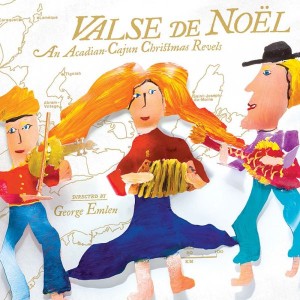 What a delightful way to end a year that was sometimes less than delightful. For 2016, The Revels has produced a program and CD of Acadian and Cajun music and dance.
What a delightful way to end a year that was sometimes less than delightful. For 2016, The Revels has produced a program and CD of Acadian and Cajun music and dance.
If you’re not familiar with The Revels (I’m not very much myself), it’s a Massachusetts-based cultural and arts organization (with affiliates in other cities) that brings together communities to celebrate their artistic and cultural traditions. Christmas Revels is but one expression of the group’s activities but perhaps the best known. I’ve heard a lot of good things about Christmas Revels but never looked into it, because I’m not too into Christmas. This CD certainly opened my mind.
The CD has a huge cast that includes a children’s choir and adult choir in addition to several musicians. It’s a generous program of 22 tracks, only a one or two of which I recognized as overtly Christmas-oriented songs. The rest is Acadian (French-Canadian from the Maritime Provinces) or Cajun music, with fiddles, accordions, Jew’s harps, mouth music and foot percussion. Some of my favorite music in the world!
Most overtly Christmas related is “Les Anges dans no campagnes,” which we know in English as “Angels we have heard on high.” It’s sung call-and-response style by the adults and children, backed by a lovely brass ensemble. “Melchior et Balthazar” is an old French carol sung by the children in French and English, accompanied by Lisa Ornstein, a well-known Pacific Northwest fiddler. It’s utterly charming as are all of the choral pieces – the kids are quite well-rehearsed and the musicians all top-notch. Other noël works include the spritely waltz “Les Cloches du hameau,” or “the village bells,” with Josée Vachon singing solo verses backed by both choirs and a small ensemble – an excellent arrangement by director George Emlen; and the nativity carol “D’où viens-tu, bergère?” a question-and-answer song by the children’s chorus.
Interspersed are Acadian dance tunes, French children’s songs like “La Poulette grise” in an unusual version from New Brunswick; “Grain de mil,” a walking song that reflects the hardship of the immigrant Acadians, and some lively Cajun two-steps from the Balfa Brothers’ repertoir.
My favorites? One is the children’s call-and-response song “I Saw The Wolf, The Fox And The Weasel,” or in French “J’ai vu le loup, le renard et la belette.” Emlen sings the lead part, the children’s chorus the echoing verses and a great Cajun ensemble backs them, and it’s all very charming. I previously knew this one from a Québécois version.
“La Rose au bois” is similarly infectious; it’s an 18th century song that’s in the Québécois, Cajun and Acadian repertoires. Josée Vachon sings the lead and the full chorus echoes, accompanied only by Québécois-style foot percussion.
Most moving is “Le Voyageur,” a sad, sad song in which the singer tells about all the things he misses in his home far away. Though it was written by a musician about missing his home, it’s universal in spirit, applicable to the Acadian refugees of the 18th century, the Holy Family in the Bible story, or the immigrants and refugees of today.
The CD booklet gives details on the songs and performers and the lyrics in French and English. You can find out more about Revels at their website.
Valse de Noël is authentic rooted music made by real folks. It’s music of the season for anyone who is tired of the same old commercial ditties and worn-out carols. It’s a gentle but hearty way to wrap up the year.
(Revels, 2016)
